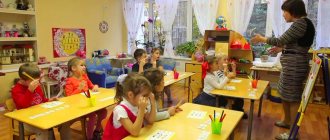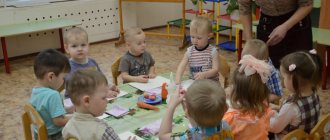Labor of younger children in nature
Labor of younger children in nature
In the second younger group received in the previous groups
ideas about nature are expanding. Caregiving skills are instilled
looking after the plants: with the help of the teacher, children feed the birds, water the plants, sow large flower seeds, plant onions, water the plants in the beds, etc.
Caring for plants is not yet available to children: the teacher does it himself, but always in the presence of children, attracts their attention
to her actions, offers to watch how water flows from a watering can, how she
absorbs into the ground; Some children can help an adult a little:
hold the watering can, pour water into it, etc.
During the work, it is necessary to explain to children that the plants are watered.
so that they grow better.
You can invite children to stroke the dense, smooth leaves of plants, smell them, admire the flowers, remember the name of this plant, etc. At the end of winter, kids plant onions. Each child plants his own bulb in a box filled with soil (the bulb can be planted almost closely).
Children are invited to first touch the soil: it is soft, loose,
look at your bulb. Then each child, as directed, does
shallow hole, puts his onion in it (with the sprout up), and then
presses it into the ground - the bulb should sit tightly in the ground.
At the end of April and beginning of May, large bean seeds are sown,
beans, nasturtium.
Labor of middle group children in nature
In the middle group, children are more independent. They purchased some
knowledge and skills for caring for plants. Now
they can already carry out daily tasks under supervision: watering
plants, spray them. Plant care at the beginning of the year is carried out in the presence of children. Gradually inviting them to help as much as possible, showing them how to pour water,
how to hold a watering can, water, wipe leaves, naming care items, teaching children to put everything in its place. First, under supervision, and then independently, children carry out tasks for caring for plants.
During the winter, children sow oats, just as kids plant onions, monitor their growth, and carefully water them (without flooding the bulbs).
Watering plants is a difficult maintenance activity for children.
.It is necessary to show how to loosen the soil in pots with a stick in the garden
accustoming children to this care.
Labor of older children in nature
In the older group, children are introduced to some methods of reproduction
plants. To do this, two or three plants are transplanted and propagated. In this
Children also take part in the work. It’s good if children observe the growth and development of their cuttings and sketch everything interesting (at their own discretion) in an album. Such an album can be used as an illustration for a conversation about plants.
.
Children's work in the preparatory group
In the school preparatory group, children are taught new care techniques: loosening, spraying. In spring - transplanting and propagating plants. They must understand the importance of this or that type of plant care.
One of the most important and difficult types of care to master is
plants are watered. Children need to be taught not only correctly
water, but also determine the lack of moisture in the pot and bed by the dryness of the top
layer of earth. When watering plants, it is necessary to take into account the development period (time
year), weather, degree of dryness of the room. During the growth period (spring and summer)
plants require abundant watering, i.e. more often, during the dormant period
(autumn and winter) - moderate, rarer
Spraying. For better plant growth in spring and summer, you don’t need them.
only water, but also spray with settled water every day.
Children can be taught to spray plants using a spray bottle or using
sprayer inserted into the bottle. First time teacher
sprays the plants himself in the presence of children and gradually involves him in this work.
In the summer, when it’s hot, it’s good to spray the plants twice a day. Necessary
Explain to the children that plants cannot be sprayed in the sun: on the leaves
burns appear. Some plants whose leaves are covered with hairs
cannot be sprayed.
Loosening. An important type of plant care is
loosening the soil in pots and garden beds. It must be explained that compacted soil is bad
allows air and water to reach the roots of plants, so plants grow worse.
The soil must be loosened very carefully so as not to damage the roots. First
while the teacher loosens the soil in the presence of children, in the future he
attracts children to help and, giving them blunt sticks, offers to loosen
soil in pots of those plants whose roots are not on the surface
land.
Children 6-7 years old already sow seeds on their own as needed:
oats, lettuce, wheat, barley; plant root crops to obtain young
greenery Sowing flower seeds for seedlings is carried out during the lesson (approximately
early May so that the seedlings do not outgrow). Before sowing the seeds should
examine, compare, remember from which plants they were collected, show
previously dried flowers or illustrations to increase children's interest in
growing these plants. You can use boxes and flower pots to grow seedlings.
It is recommended to cover the sown seeds with sand, which is better
allows air to pass through, resulting in more complete aeration; sand when watering
washes off as easily as soil, as it turns into crust after watering,
settles easily and allows water to pass through. After sowing, the sand-covered soil is sprayed again. Crops should be protected from drying out and sudden fluctuations
temperature; you need to give them as much light as possible.
When the seedlings grow, they need to be planted (picking), after which
they will grow quickly. Observations of the development and growth of plants should be carried out before transplanting into the ground and continue after planting on the site.
In the preparatory group, it is advisable to grow two or three types of vegetables and
colors. It is not necessary to grow all the plants that you want to plant
on a plot of seedlings. The whole point of this work is to
show children the growth and development of a plant from sowing a seed to obtaining new ones
fruits and seeds. It is more convenient to grow seedlings in paper cups, in
peat pots or in ordinary small flower pots.
For seedlings grown in pots, the earthen lump is not destroyed when planted,
The seedlings take root well and do not get sick. Making paper cups and
planting seedlings is carried out with children in classes.
Children's work by month
JANUARY
Preparing the soil for growing seedlings
Preparing containers for sowing seedlings
Checking seeds for germination. To do this, a damp sheet of paper is folded like an accordion, at least 3 seeds are poured into each “furrow” and placed in a warm place until the seeds germinate.
Planting onions, watering onions. (ml. gr)
FEBRUARY
You need to determine which seeds you will plant in the greenhouse and prepare them.
Sowing celery root seeds for seedlings
Sowing seedlings of tall and medium-sized tomatoes
independent watering of plants (old, warmed up), care of plantings
MARCH
Sowing leek and nigella seeds for seedlings
Sowing mid-late cabbage varieties
Spraying plants together with the teacher
Planting care, loosening, watering, picking (old gr.)
APRIL
When the snow melts and the ground dries out a little, you should begin to prepare the soil for sowing vegetable seeds. It is necessary to harrow all the beds dug up in the fall with a rake or dig them up again
Sowing cucumber seeds for seedlings for greenhouses
Sowing seeds of zucchini, pumpkin,
Preparing greenhouses for cucumbers, tomatoes and squash
Sowing peas and beans
Spraying plants together with the teacher, replanting, loosening
Growing outdoor flower seedlings
MAY
Planting tall tomatoes sown in February in a greenhouse. Planting seedlings of early white cabbage and Brussels sprouts sown in March in open ground.
Cucumbers are sown as seeds or seedlings in open ground in a warm bed. Planting seedlings of zucchini, pumpkin and squash for April sowing in open ground.
Sowing seeds of zucchini, pumpkin and squash in open ground
Sowing turnips and radishes for summer consumption Sowing seeds or planting April seedlings of cucumbers in the warmth
Sowing beets and carrots
Planting potatoes We plant seedlings or sow seeds of heat-loving green crops
Sowing bean seeds
It is also necessary to take care of the plants (loosening, watering, weeding). It is always better to water in the evening, with water that has stood in a barrel in the sun.
Provide supports for peas, beans and tomatoes
JUNE
Re-seeding radishes, radishes, dill and lettuce
Tie cucumbers (if necessary)
Cucumbers in the fifth-sixth true leaf phase should be pinched at the end of the vine in order to develop lateral vines.
Hill up the potatoes, loosen the rows,
Thin out carrot and beet seedlings.
JULY
Sowing radishes for winter storage
Watering plants
Removing weeds from garden beds
Partial harvest of cucumbers
AUGUST
Onion harvesting
Watering plants
Loosening the soil
Partial harvest of tomatoes
SEPTEMBER
Potato harvesting
Harvesting carrots and beets
Together with the teacher, collect natural materials and place them in boxes by type (ml. grams)
On the site, together with the teacher, cleaning up fallen leaves and replanting flowering plants
Collecting seeds for winter feeding of birds
Collection of natural materials for crafts.
Collection of beautiful leaves for a bouquet in a natural corner
OCTOBER
Continue harvesting vegetables: celery (root vegetables), parsley (root vegetables), turnips
NOVEMBER
Preparing greenhouses for winter (digging beds)
Help the teacher in cleaning up dry leaves on the site (ml. g)
Installation of feeders, feeding birds
DECEMBER
Bird feeding,
Caring for indoor plants (trimming dry leaves, watering)
Sowing oats, lettuce, planting onions in a corner of nature (old gr.)
Get text
Preview:
Summary of educational activities on labor education in a corner of nature
Author: Natalya Vasilievna Masalskaya, Municipal Educational Institution No. 163, Kemerovo “We water indoor plants - we do good deeds”
(second junior group)
Types of children's activities: gaming, communicative, cognitive and research.
Goal: acquaintance with violet, creating conditions for labor education in a playful way.
Educational: to consolidate and supplement children’s knowledge about plant care techniques: to teach the difference between a watered plant (dark, damp soil) and an unwatered plant (light, dry soil); Developmental: to develop the ability to perform work in a certain sequence. Educational: continue to cultivate interest and love for plants, the desire to care for them.
Vocabulary work. Encourage students to use words in speech: violet, care, water, wipe leaves, smooth, shiny.
Daily care of plants in a corner of nature; knowledge of plant names; ficus, consideration of visual and didactic material on the topic: “Indoor plants” (Flowers).
Materials and equipment:
On the teacher’s desk there is a violet plant (specimens) and a watering can with water. There are children's chairs and oilcloth children's aprons in front of the table.
Contents of organized activities for children:
(Children are next to the teacher)
Educator: Guys, do you know what good deeds are? (Children answer) Yes, guys, good deeds bring joy to everyone, lift everyone’s spirits, take them away from trouble, etc. Tell us what good deeds you have already learned to do (wiping dust from toys, untying each other’s shoelaces, laying out pencils, plasticine, boards for activities, watering indoor plants, etc.).
— When we water and wash a flower, to whom are we doing a good deed? Children: flower (plant).
- That's right, without our care the flower will not grow and bloom.
Educator: guys, let's see who came to us?
Children: girl daisy.
Educator: That’s right, this is a girl called Daisy.
Girl Romashka: Hello, guys!
Children: Hello, Daisy Girl!
Educator: Guys, what is the Girl holding a daisy in her hands?
Children: a pot with a houseplant.
Educator: Yes, guys, this is a pot with a houseplant that has limp, drooping leaves. What is the name of this plant?
Educator: Guys. This houseplant is a violet.
Girl Chamomile: No matter how much I washed this plant, it still remained somehow not beautiful and sad. How to help the violet plant?
Educator: What needs to be done with the plant to make it beautiful again?
Children water the plants and place them in a sunny place.
The teacher invites the children and Girl Romashka to go and sit on the chairs.
Educator: In front of you, children, are plants. What is the name of this plant?
Educator: Look: what kind of soil does this (show) plant (which stood on the teacher’s table), what color?
Educator: come and touch the ground. What does it feel like?
Educator: Now look at the soil of the other plant (which the Chamomile Girl brought). Same color?
Children: No, light.
Educator: come and touch the ground. What is she like?
Educator: Which of these plants do you think has already been watered and which has not?
Children: The one that stood on the table was watered, but the one that the Chamomile Girl brought - no, it was not watered.
— How can you find out whether a plant needs to be watered? (By the color of the earth and to the touch).
Girl Chamomile: Can I water the plant?
Educator: Of course, come and water the plant.
Girl Chamomile: I know how to do this, and suggests pouring a bucket of water on top of the plant.
Educator: You can’t water plants like that. Children, why can’t this be done? (Answers from children and teacher).
— You can flood the plant, pour water on the floor, etc.
The teacher asks the child to come up and water a plant that has not been watered. Is it right. chose a plant? Is he watering it correctly? The teacher comments on his actions and encourages: . holds the watering can correctly, the spout of the watering can rests on the edge of the pot. In the absence of moisture (water), the plant (leaves, stem) lose their elasticity and droop. You need to water until water appears on the tray. . So we watered your plant. Now we will put the violet in a sunny place, because... flower - will grow well where there is a lot of light and warmth.
- But our guys not only know how to water the plant, but also wash them well (wipe the leaves). The teacher shows a houseplant known to the children (ficus) and asks them to remember its name.
(Children answer) saying the name of the plant.
Then the teacher asks the children what the “ficus” looks like, a tree or grass, what kind of leaves it has, large or small, what color are they? (Children answer).
- We took care of the plant (ficus), watered it, washed it - and now it has grown - it has become like a small tree, it has large green smooth leaves.
(Children complete the task), the teacher comments: “Take rags, wet them, wring them out so that water does not drip from them, straighten them; place a leaf on the palm of one hand and, supporting it from below, slowly and carefully run the cloth over it in one direction from the petiole to the end at the top, and then at the bottom. You need to wash it carefully so that the leaf does not break. Rinse the cloth and also wipe the next sheet.”
- And now all the children will wipe the leaves of the plants.
The teacher invites the Camomile Girl to help the children.
- Well done, guys, they work well (praises the teacher).
Teacher: “We’ve done our work, rinse the cloths, wring them out, we’ll hang them on the radiator to dry. Next time we wash the plants, the cloths will be clean.”
After all the leaves of the plants are clean, the teacher invites one of the children to take watering cans and water the plants that have not yet been watered today. Watering the onion is our garden.
Reading the poem by I. Voronko “Don’t stop me from working.”
Don't stop me from working
I'll bring some water
And well water
Of course, I’ll treat everyone.
He drinks water too!
The children work, the teacher helps them with advice if necessary. Then the teacher offers to look at the plants - how clean and beautiful (well-groomed) they have become.
The teacher, chamomile and children arrange indoor plants in a corner of nature.
Game "Find the flower".
Goal: to teach children to correctly find and name flowers, develop memory, thinking, and cultivate a love of nature.
(The teacher shows a card with a picture of a flower - the children find the same flower - in a corner of nature.)
At the suggestion of the teacher, the children give Pinocchio a clean, blooming and well-groomed plant - balsam (light) with the request that Pinocchio does not forget to care for the plant.
Chamomile thanks and says goodbye to everyone.



